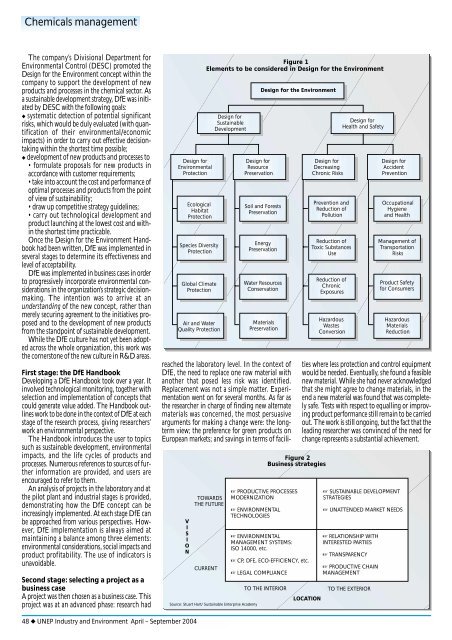industry and environment - DTIE
industry and environment - DTIE
industry and environment - DTIE
You also want an ePaper? Increase the reach of your titles
YUMPU automatically turns print PDFs into web optimized ePapers that Google loves.
Chemicals management<br />
The company’s Divisional Department for<br />
Environmental Control (DESC) promoted the<br />
Design for the Environment concept within the<br />
company to support the development of new<br />
products <strong>and</strong> processes in the chemical sector. As<br />
a sustainable development strategy, DfE was initiated<br />
by DESC with the following goals:<br />
◆ systematic detection of potential significant<br />
risks, which would be duly evaluated (with quantification<br />
of their <strong>environment</strong>al/economic<br />
impacts) in order to carry out effective decisiontaking<br />
within the shortest time possible;<br />
◆ development of new products <strong>and</strong> processes to<br />
• formulate proposals for new products in<br />
accordance with customer requirements;<br />
• take into account the cost <strong>and</strong> performance of<br />
optimal processes <strong>and</strong> products from the point<br />
of view of sustainability;<br />
• draw up competitive strategy guidelines;<br />
• carry out technological development <strong>and</strong><br />
product launching at the lowest cost <strong>and</strong> within<br />
the shortest time practicable.<br />
Once the Design for the Environment H<strong>and</strong>book<br />
had been written, DfE was implemented in<br />
several stages to determine its effectiveness <strong>and</strong><br />
level of acceptability.<br />
DfE was implemented in business cases in order<br />
to progressively incorporate <strong>environment</strong>al considerations<br />
in the organization’s strategic decisionmaking.<br />
The intention was to arrive at an<br />
underst<strong>and</strong>ing of the new concept, rather than<br />
merely securing agreement to the initiatives proposed<br />
<strong>and</strong> to the development of new products<br />
from the st<strong>and</strong>point of sustainable development.<br />
While the DfE culture has not yet been adopted<br />
across the whole organization, this work was<br />
the cornerstone of the new culture in R&D areas.<br />
First stage: the DfE H<strong>and</strong>book<br />
Developing a DfE H<strong>and</strong>book took over a year. It<br />
involved technological monitoring, together with<br />
selection <strong>and</strong> implementation of concepts that<br />
could generate value added. The H<strong>and</strong>book outlines<br />
work to be done in the context of DfE at each<br />
stage of the research process, giving researchers’<br />
work an <strong>environment</strong>al perspective.<br />
The H<strong>and</strong>book introduces the user to topics<br />
such as sustainable development, <strong>environment</strong>al<br />
impacts, <strong>and</strong> the life cycles of products <strong>and</strong><br />
processes. Numerous references to sources of further<br />
information are provided, <strong>and</strong> users are<br />
encouraged to refer to them.<br />
An analysis of projects in the laboratory <strong>and</strong> at<br />
the pilot plant <strong>and</strong> industrial stages is provided,<br />
demonstrating how the DfE concept can be<br />
increasingly implemented. At each stage DfE can<br />
be approached from various perspectives. However,<br />
DfE implementation is always aimed at<br />
maintaining a balance among three elements:<br />
<strong>environment</strong>al considerations, social impacts <strong>and</strong><br />
product profitability. The use of indicators is<br />
unavoidable.<br />
Second stage: selecting a project as a<br />
business case<br />
A project was then chosen as a business case. This<br />
project was at an advanced phase: research had<br />
Design for<br />
Environmental<br />
Protection<br />
Ecological<br />
Habitat<br />
Protection<br />
Species Diversity<br />
Protection<br />
Global Climate<br />
Protection<br />
Air <strong>and</strong> Water<br />
Quality Protection<br />
Figure 1<br />
Elements to be considered in Design for the Environment<br />
Design for<br />
Sustainable<br />
Development<br />
V<br />
I<br />
S<br />
I<br />
O<br />
N<br />
TOWARDS<br />
THE FUTURE<br />
CURRENT<br />
Source: Stuart Hart/ Sustainable Enterprise Academy<br />
Design for<br />
Resource<br />
Preservation<br />
Design for the Environment<br />
Soil <strong>and</strong> Forests<br />
Preservation<br />
Energy<br />
Preservation<br />
Water Resources<br />
Conservation<br />
Materials<br />
Preservation<br />
Figure 2<br />
Business strategies<br />
☞ PRODUCTIVE PROCESSES<br />
MODERNIZATION<br />
☞ ENVIRONMENTAL<br />
TECHNOLOGIES<br />
☞ ENVIRONMENTAL<br />
MANAGEMENT SYSTEMS:<br />
ISO 14000, etc.<br />
☞ CP, DFE, ECO-EFFICIENCY, etc.<br />
☞ LEGAL COMPLIANCE<br />
TO THE INTERIOR<br />
Design for<br />
Decreasing<br />
Chronic Risks<br />
Prevention <strong>and</strong><br />
Reduction of<br />
Pollution<br />
Reduction of<br />
Toxic Substances<br />
Use<br />
Reduction of<br />
Chronic<br />
Exposures<br />
Hazardous<br />
Wastes<br />
Conversion<br />
Design for<br />
Health <strong>and</strong> Safety<br />
Design for<br />
Accident<br />
Prevention<br />
Occupational<br />
Hygiene<br />
<strong>and</strong> Health<br />
Management of<br />
Transportation<br />
Risks<br />
Product Safety<br />
for Consumers<br />
Hazardous<br />
Materials<br />
Reduction<br />
reached the laboratory level. In the context of<br />
DfE, the need to replace one raw material with<br />
another that posed less risk was identified.<br />
Replacement was not a simple matter. Experimentation<br />
went on for several months. As far as<br />
the researcher in charge of finding new alternate<br />
materials was concerned, the most persuasive<br />
arguments for making a change were: the longterm<br />
view; the preference for green products on<br />
European markets; <strong>and</strong> savings in terms of facilities<br />
where less protection <strong>and</strong> control equipment<br />
would be needed. Eventually, she found a feasible<br />
new material. While she had never acknowledged<br />
that she might agree to change materials, in the<br />
end a new material was found that was completely<br />
safe. Tests with respect to equalling or improving<br />
product performance still remain to be carried<br />
out. The work is still ongoing, but the fact that the<br />
leading researcher was convinced of the need for<br />
change represents a substantial achievement.<br />
LOCATION<br />
☞ SUSTAINABLE DEVELOPMENT<br />
STRATEGIES<br />
☞ UNATTENDED MARKET NEEDS<br />
☞ RELATIONSHIP WITH<br />
INTERESTED PARTIES<br />
☞ TRANSPARENCY<br />
☞ PRODUCTIVE CHAIN<br />
MANAGEMENT<br />
TO THE EXTERIOR<br />
48 ◆ UNEP Industry <strong>and</strong> Environment April – September 2004
















